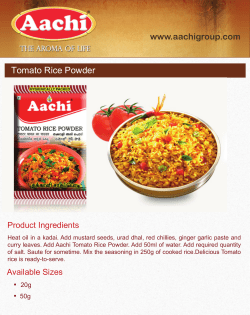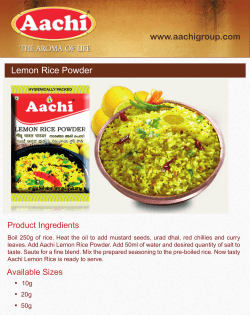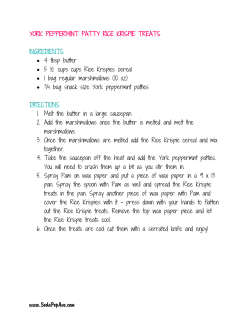
DAY 1 INTRODUCTION Rangoli mythology)
DAY 1 INTRODUCTION Rangoli is a Hindu folk art, generally created on a floor on special festive occasions. The origin of this art can be traced to the Puranas (works on Hindu mythology). Simply put, Rangoli means a row of colors. The tradition of Rangoli originated in Maharastra and slowly disseminated to other parts of India. Origin Rangoli, also known as Kolam in South India, Chowkpurana in Northern India, Madana in Rajasthan, Aripana in Bihar, Alpana in Bengal is the ancient Hindu religious floor art. According to a legend recorded in Chitra Lakshana, the earliest treatise on Indian painting, a king and his kingdom were steeped in sorrow at the death of the high priest's son. Everybody prayed to Lord Brahma, who moved by the prayers, asked the king to paint a portrait of the boy on the floor so that he could breathe life into it. And with that the art of floor painting came to life. And that is how rice, flour and flowers were transformed into picturesque offerings to God in the form of floor painting. Creative Expression 'Rangoli' is a sanskrit word which means a creative expression of art through the use of color. In ancient India, rangolis were used to decorate the entrances of homes, a floor painting which provided a warm and colorful welcome to visitors. In Indian cultures, all guests and visitors occupy a very special place, and a rangoli is an expression of this warm hospitality. In particular, the Diwali festival is widely celebrated with rangoli, since at this time, people visit each other's homes to exchange greetings and sweets. In a rangoli, powdered colors are sprinkled on cleaned and dusted floors to form decorations. Rangolis can be vivid, three -dimensional art complete with sh adings or they can be the traditional plain, yet as beautiful as, two -dimensional designs. The colored powder is usually applied 'freehand' by letting it run from the gap formed by pinching the thumb and the forefinger. In ancient times, rangolis were ac tually decorations made on the entrances and walls of houses to brighten up and add color to occasions being celebrated, like weddings, births and significant religious days. They also signified a warm welcome for visitors. In fact in Maharashtra, India, h ousewives make them each morning. The designs would be simple and geometrical but could invoke symbolic forms. Oil lamps (diyas) would be placed in the rangoli to give it yet another dimension. Thus, reflecting regional beliefs and aesthetics based on a common spiritual plane the art of floor painting is one which has survived all influences and retained and transmitted the spirit of Indian life. DAY 2 To begin with … Give the following instructions to the participants Choose a design that you want to d raw. You may find designs from books and magazines or you may try to create your own design. Rangoli designs are symmetrical in nature and geometric in shape. If you want to try out a design of your own, first draw it on a piece of paper and fill in the de sign with coloured sketch pens to get an idea about how the rangoli will look. Wipe the floor (where you want to create the rangoli) with a wet cloth and wait for the area to dry. With a piece of chalk, first draw the outline of the rangoli design. Now it's time to fill in the outline with rangoli powder, the most challenging part of the whole exercise. Pick up some powder with your thumb and index finger and fill in the design by rubbing the two fingers together and sprinkling the powder on the floor. T ake care to sprinkle the powder carefully, don't let powders of two different colours merge with each other. Start from the centre and move outwards. You can use traditional colours like flour of rice and dal. But easily available colours like gulal, k umkum or even poster colours can be used. You may create spaces within the rangoli design to place diyas. You could also use flower petals of different colours (golden marigolds, bright red roses) to add that extra dimension to your design. With a little bit of imagination, a dash of aesthetic sense and dollops of patience, you can create a piece of art Make a stencil and use it to make harmonious patterns. Options for Coloring: gulal, kumkum petals of different flowers and leaves Pastel crayons and poster colours Rice paste Colored sawdust, small thin pieces of stones grains, pulses, cereals (Saw dust can be coloured with the help of dyes and should be done a night before) *Colored rice is another choice: *To food color rice, add a healthy amount of food coloring to two 1 tsp of rubbing alcohol in a Ziploc bag. Pour in about 3/4 cup of UNCOOKED rice. Close the bag and shake well . Pour onto a piece of wax paper or tinfoil to dry (Making the colored rice is messy and food color doesn't come out of clothes therefore the shaking part should be done carefully. Let dry (about 1/2 a day -- less if you spread them out well in a warm airy place. ) Food coloring Paste can also be used instead of drops. Tell the participants that we wi ll begin with simple patterns with the help of 4X4 points. Tell them to fill the pattern using coloured saw dust. Day 3 RANGOLI AT THE ENTRANCE 1. With the help of chalk and the rope draw a semicircle at the entrance as shown in the diagram 2. Draw a rangoli using free hand drawing around the semi circle 3. Colour the rangoli using flowers Day 4: KINARI This type of rangoli is usually done around flowerpots, on the steps lead ing to stage or on the threshold of the main door of the house Draw rangoli – using 4 points – Using 5 points – Using 7 points – Free hand Some of the coloured patterns are shown as below. (Note: Stencil can be used for replicating the pattern) Day 4 Rangoli for Puja Ghar Auspicious symbols such as the swastik, kalash, aum lotus and geometrical shapes like triangle, hexagon make a beautiful rangoli in Puja Ghar. It can be made more attractive by arranging colorful flowers and leaves on it. NOTE: Do not use black colour for making rangoli for Puja Ghar Some of Designs are as follow: DAY 5 Floral Rangoli A floral design will make a beautiful rangoli. But it can be made more attractive by arranging colorful flowers and leaves on it Day 6: Rangoli for the corners: Draw the pattern on the corners of the room and fill them using flowers and leaves. DAY 7 Rangoli During Diwali Introduction During Diwali, Goddess Lakshmi is believed to visit homes that are well lit, so families decorate their homes. People wear their best clothes or buy new ones, children are giv en presents and new year greetings are exchanged through visits or Diwali cards. Thus, a Rangoli design is created on doorsteps to welcome everybody. Rangoli exudes a pattern in color that are specific for each region. During Diwali, in the art of floor painting, the central rangoli design is the symbolic one denoting the deity or the theme. Motifs generally created are lotus, fish, birds, snakes etc. which reflects the unity of man and beast. Most of the rangoli designs are circular exuding a sense of endlessness of time. Celestial symbols such as the sun, moon and other zodiac signs are also common themes for rangoli. Layered with symbolism is the lotus denoting Goddess Lakshmi, the unfolding of life, the heart or the wheel . During Diwali, two interfac ed triangles are created that indicates the deity of learning, Sarswati. Encircling this is a 24 -petal lotus flower border, the outer circle being decorated with Lakshmi's footprints repeated in four corners. Sometimes the lotus petals are made in a triangular shape for variety. In north Bihar, Lakshmi's feet are drawn at the door, the toes pointing inwards to indicate her entrance. Again in Andhra Pradesh there is an eight-petal lotus (ashtadal kamal) and many geometric patterns forming the lotus. In Tam il Nadu the hridaya kamalam is an eightpointed star meaning lotus of the heart. In Maharasthra too the lotus is a basic motif and designs like shankh kamal - shell lotus and thabak which means salver is in the shape of an eight-petal lotus with straight lines elaborated with curving lines to give it the appearance of a salver. In Gujarat alone there are said to be 1001 variations of the lotus that are drawn during Diwali, the festival when Goddess Lakshmi is worshiped. Other motifs are swastikas and conch shells. All over the southern part of India the Diwali festival is marked by gaiety and prosperity. The rangolis drawn are peripheral. Most Rangolis are basically geometric patterns formed with dots and lines to make squares, circles, swastikas, lotus, trident, fish, conch shell footprints, creepers, trees bear testimony both to individual genius and community participation and many work for days together on single design. The raw materials mainly used to make rangoli are edibles like rice flour, pulse and flowers and leaves. All over India, floor paintings are essentially white in color. White is a symbol of peace, purity and tranquility. The material used is rice flour or rice paste, because rice to all Indians is a sign of prosperity. Yet another symb ol of prosperity is the color yellow. Turmeric yellow or ocher is also often used to fill in the white outlines. More often however, vermilion is used. Vermilion, is considered auspicious. Also used are pea green and rust brown. Creating a rangoli and then tastefully arranging small lamps on it will make it more colourful and glowing. Some of the patterns for rangoli that are commonly used during Diwali Decorate the following rangolis by arranging diyas on it DAY 8 Rangoli on Thali This is a very easy, novel and unique way of making rangoli. Dip cotton in the oil and apply it on the thali Spread the colour on the thali with the help of sieve Make a freehand design on it with the help of your finger Place a diya in the center. Wherever there is pattern that you have made by your finger, the shining steel of the thali will appears very beautiful
© Copyright 2025













